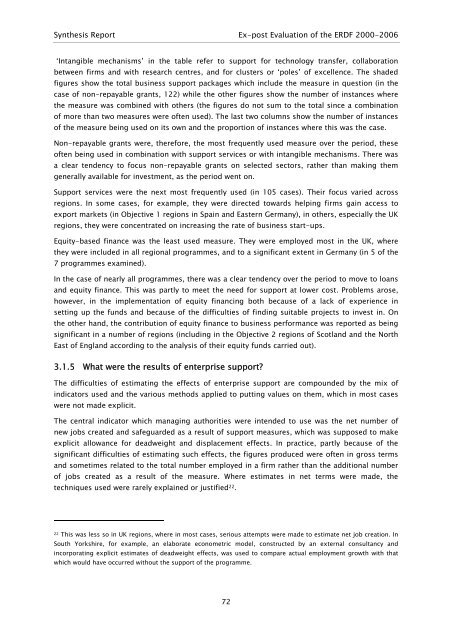Synthesis Report - European Commission - Europa
Synthesis Report - European Commission - Europa
Synthesis Report - European Commission - Europa
You also want an ePaper? Increase the reach of your titles
YUMPU automatically turns print PDFs into web optimized ePapers that Google loves.
<strong>Synthesis</strong> <strong>Report</strong> Ex-post Evaluation of the ERDF 2000-2006<br />
‘Intangible mechanisms’ in the table refer to support for technology transfer, collaboration<br />
between firms and with research centres, and for clusters or ‘poles’ of excellence. The shaded<br />
figures show the total business support packages which include the measure in question (in the<br />
case of non-repayable grants, 122) while the other figures show the number of instances where<br />
the measure was combined with others (the figures do not sum to the total since a combination<br />
of more than two measures were often used). The last two columns show the number of instances<br />
of the measure being used on its own and the proportion of instances where this was the case.<br />
Non-repayable grants were, therefore, the most frequently used measure over the period, these<br />
often being used in combination with support services or with intangible mechanisms. There was<br />
a clear tendency to focus non-repayable grants on selected sectors, rather than making them<br />
generally available for investment, as the period went on.<br />
Support services were the next most frequently used (in 105 cases). Their focus varied across<br />
regions. In some cases, for example, they were directed towards helping firms gain access to<br />
export markets (in Objective 1 regions in Spain and Eastern Germany), in others, especially the UK<br />
regions, they were concentrated on increasing the rate of business start-ups.<br />
Equity-based finance was the least used measure. They were employed most in the UK, where<br />
they were included in all regional programmes, and to a significant extent in Germany (in 5 of the<br />
7 programmes examined).<br />
In the case of nearly all programmes, there was a clear tendency over the period to move to loans<br />
and equity finance. This was partly to meet the need for support at lower cost. Problems arose,<br />
however, in the implementation of equity financing both because of a lack of experience in<br />
setting up the funds and because of the difficulties of finding suitable projects to invest in. On<br />
the other hand, the contribution of equity finance to business performance was reported as being<br />
significant in a number of regions (including in the Objective 2 regions of Scotland and the North<br />
East of England according to the analysis of their equity funds carried out).<br />
3.1.5 What were the results of enterprise support?<br />
The difficulties of estimating the effects of enterprise support are compounded by the mix of<br />
indicators used and the various methods applied to putting values on them, which in most cases<br />
were not made explicit.<br />
The central indicator which managing authorities were intended to use was the net number of<br />
new jobs created and safeguarded as a result of support measures, which was supposed to make<br />
explicit allowance for deadweight and displacement effects. In practice, partly because of the<br />
significant difficulties of estimating such effects, the figures produced were often in gross terms<br />
and sometimes related to the total number employed in a firm rather than the additional number<br />
of jobs created as a result of the measure. Where estimates in net terms were made, the<br />
techniques used were rarely explained or justified 22 .<br />
22 This was less so in UK regions, where in most cases, serious attempts were made to estimate net job creation. In<br />
South Yorkshire, for example, an elaborate econometric model, constructed by an external consultancy and<br />
incorporating explicit estimates of deadweight effects, was used to compare actual employment growth with that<br />
which would have occurred without the support of the programme.<br />
72

















